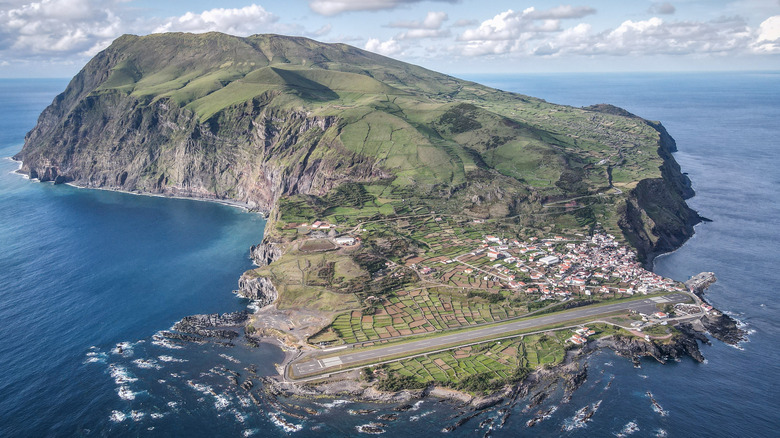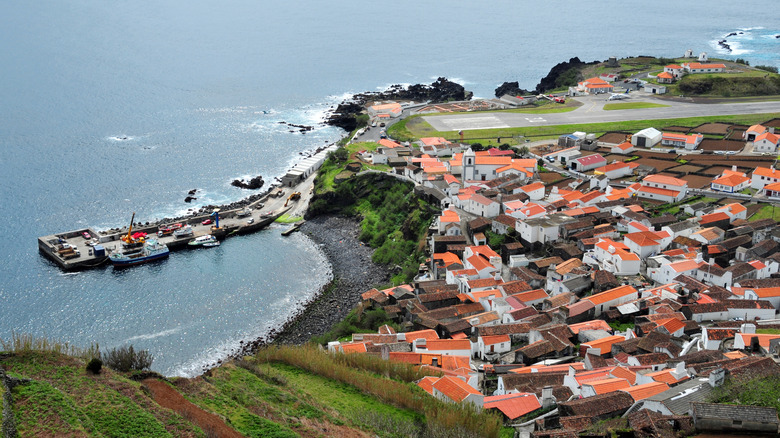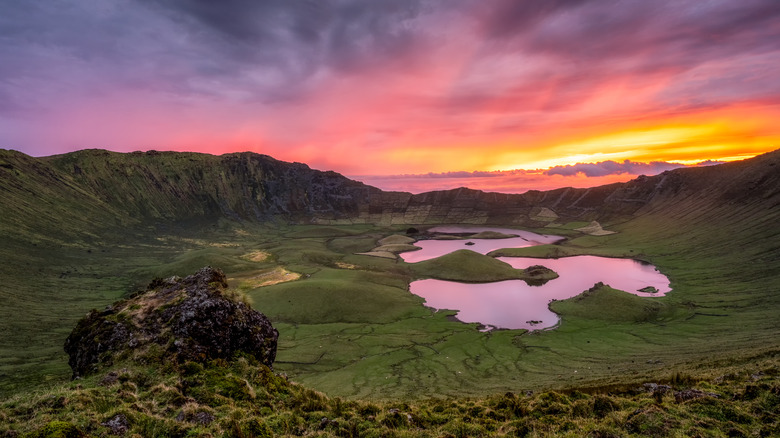The Isolated European Island With Unique Quirks And So Much To Explore
With an area of 6.8 square miles, a single town, and a population that hovers around 400, Corvo — the smallest island in Portugal's Azores — is either a really tiny island or a very large rock, depending on how you look at it. The obvious question is, why would anyone want to visit such a teeny tiny place? Is there anything to do there? The answer is a resounding yes. But even more importantly, there are fascinating people to meet and a new way of life to experience.
However, if you're the kind of person who likes to tick boxes on your sightseeing list, then this place is probably not for you. If you prefer your ocean views with beachside bars and world-class golf courses rather than with a quaint village and cow-speckled pastures, best to steer your ship to another island of the Azores archipelago. On the other hand, if you're someone who would appreciate encountering one of the quirkiest and most remote settlements in all of Europe, whose resident Corvinos are an unusual blend of fierceness, resourcefulness, and generosity, there might be something magical waiting for you here in the middle of the North Atlantic.
Corvo's quirky and only village
Corvo's only town, Vila do Corvo, is a delightful jumble of white buildings with orange-tiled roofs scattered along cobblestone streets. Adjacent to the town is a small airstrip, a reminder that the modern world lies out there somewhere. Corvo walks to the beat of its own drum and hasn't really kept pace with the times — islanders only began using electricity after 1963.
Examining the buildings more closely, you might notice that some have peculiar wooden locks. Corvino craftsmen began making these wooden locks and keys around 500 years ago, as metals were difficult to come by in the middle Atlantic. According to local legend, the Corvinos created the locks to protect their homes and belongings from pirates, who were frequent visitors to the archipelago in those days. The locks are now part of the island's unique cultural heritage and identity, along with the traditional blue woolen caps made from sheep's wool that are called barretas.
While the wooden locks remain, few residents use them now, as they all know and trust each other. If you want something your neighbor has, why not just go borrow it? Another hallmark of Corvino society is their sense of solidarity, built on centuries of pulling together to survive fierce storms, attacking pirates, and other dangers. Don't miss an opportunity to chat with these tough, humble people, who enjoy seeing new faces and sharing stories about their lives.
Corvo's spectacular nature and birds
Nature lovers will be thrilled to know that the entire island along with its surrounding marine area is a UNESCO World Biosphere Reserve, with the highest density of rare, endangered, and endemic species of any island in the archipelago. The best way to discover Corvo's flora and fauna is to strike out on foot. One thing's for sure — you won't need to worry about getting lost. The hike around the island's stunning Caldeirão on the PRC2COR trail has some of the most spectacular scenery in the Azores. PR1COR is another amazing trail that leads from the caldera to Praia da Areia, a beautiful black-sand beach.
Humans are not the only species that appreciate Corvo's pristine landscapes. The island is also a paradise for birds, especially migratory species that stop over when crossing the Atlantic. In October, when migratory species are most abundant on the island, birdwatchers from all over the world flock to the island to witness the squawking spectacle. All that hiking and birding has you feeling a bit famished? Head past the airstrip to Caldeirão, the island's only real restaurant, for an all-you-can-eat lunch buffet or reasonably priced dinners. With sweeping views of the ocean and some historic windmills, the restaurant's patio is a great place to sit back and do absolutely nothing while taking it all in.


